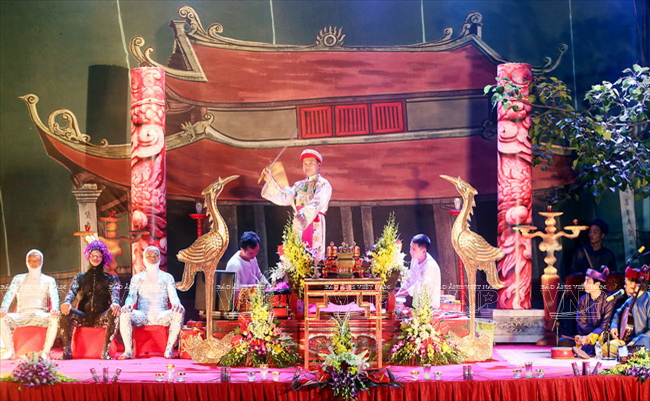Lanh Giang Temple, also known as Lanh Giang Linh Tu, is one of the favourite destinations for tourists nationwide because of its spiritual values and unique festival.
Lanh Giang Temple is located near the confluence of the Red River and the Lanh River in Yen Lac Village, Moc Nam Commune, Duy Tien District, in northern Ha Nam Province. As the tale goes, the temple is dedicated to three water generals who helped King Hung Due Vuong, the 18th Hung King (about the 3rd century BC) defeat the enemy. Also, the temple honours Princess Tien Dung, the daughter of King Hung Due Vuong, and Chu Dong Tu, one of the four immortal saints in Vietnam.
According to the ancient words carved on its roof, the temple was built during the Ly Dynasty (the 11th - 12th century). The total area of the temple is 3,000m2, peppered with ancient trees. It is an imposing structure. The three-entrance gates have eight roofs carved with images of dragons, the moon and stylised leaves. In front of the main gate is a semicircular pond with a tower in the middle connected to the bank by a bridge carved with dragons.The pagoda was built according to the Noi Cong Ngoai Quoc (nei gong wai quo) architectural style. Inside the temple there are many valuable worshipping objects, such as the statue of Princess Tien Dung, statues of the three generals which were carved delicately, two palanquins and many altars and parallel sentences.

The palanquin procession is about two kilometres long on the dike near the Lanh River. Photo: Trinh Van Bo/VNP

The palanquin procession during Lanh Giang Temple's Festival.

The procession from Lanh Giang Temple to Tien Dung Temple. Photo: Trinh Van Bo/VNP

The palanquin procession from Tien Dung Temple to Lanh Giang Temple. Photo: Trinh Van Bo/VNP

The procession of offerings during Lanh Giang Temple’s Festival. Photo: Trinh Van Bo/VNP

All rites are solemnly held during the festival. Photo: Trinh Van Bo/VNP

The drum beat team in the palanquin procession during Lanh Giang Temple’s Festival. Photo: Trinh Van Bo/VNP

Instrumentalists participate in the procession at Lanh Giang Temple’s Festival. Photo: Trinh Van Bo/VNP |
Every year in June according to lunar calendar, local residents are eager to organise the temple’s festival which has existed for a long time with many unique cultural features. The most traditional feature during the festival is a show of Hau dong that reproduces tales of gods worshipped at the temple.
The ceremonial part of the festival consists of a palanquin procession with the participation of a large number of locals and tourists. The procession starts from Lanh Giang Temple to Tien Dung Temple where some rites are solemnly held and then the palanquin is brought back to Lanh Giang Temple. The procession is about two kilometres long.
Spicing up the festival is a host of activities, including dragon dances, traditional opera singing, wrestling and games of human chess. There’s also a competition to cook rice in bamboo frames, cockfighting, a duck catching game and a swimming race.
Participating in the festival, tourists are charmed by a show of Hat van-Hau dong, a kind of psychic dance that claims to respond to occult powers and expresses the will and orders of a super-natural being.The centre of attention during Hau dong performances is the medium who dances in front of the altar. To the right of the altar sit two musicians or more, who play a Dan nguyet (moon lute), a flute, a drum, castanets, a gong and cymbals. Hau dong performers are considered to have special powers connecting with spirits. Actually, Hau dong praises gods and historical heroes. Its cultural values can’t be ignored and the cultural institute plans to nominate the art form to UNESCO as an intangible heritage.

A fire-work performance to open Lanh Giang Temple’s Festival. Photo: Trinh Van Bo/VNP
A Hau dong performance at the opening ceremony of Lanh Giang Temple’s Festival. Photo: Trinh Van Bo/VNP

A unique dragon dance in Lanh Giang Temple’s Festival. Photo: Trinh Van Bo/VNP |
With distinctive cultural features, Lanh Giang Festival is a great event for the whole community so during the festival the temple is full of pilgrims paying their respects to the spirits.
By Trinh Van Bo